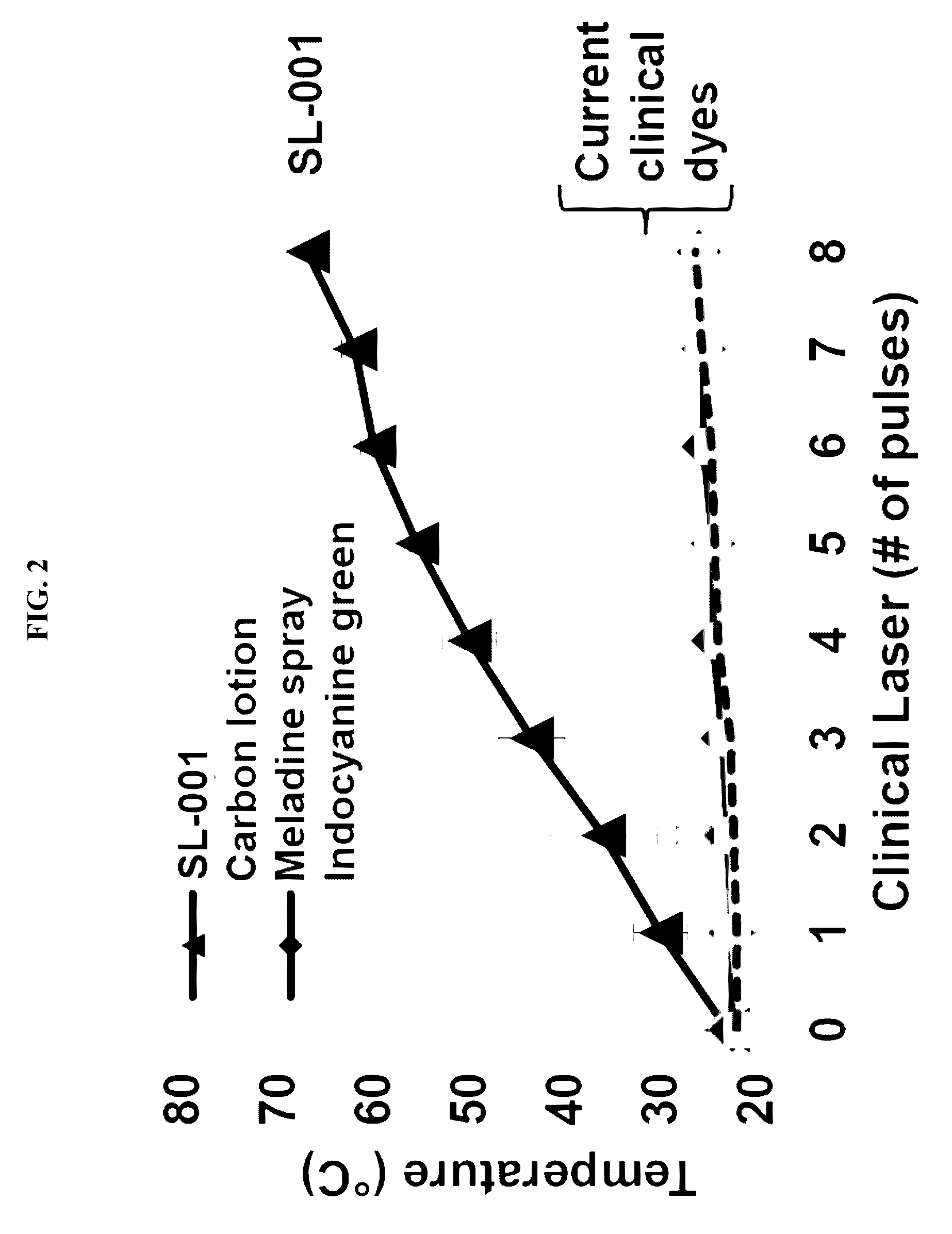Ultrasound delivery of nanoparticles
a nanoparticle and ultrasonic technology, applied in the field of nanoparticles and/or photoactive compounds, can solve the problems of long healing time and risk of side effects, long postoperative recovery period, scarring, etc., and achieve the effect of reducing the incidence of complications, avoiding prolonged and unpleasant postoperative recovery period, and avoiding oozing and burning discomfor
- Summary
- Abstract
- Description
- Claims
- Application Information
AI Technical Summary
Benefits of technology
Problems solved by technology
Method used
Image
Examples
example 1
Generation of Plasmonic Nanoparticles for Thermomodulation
[0206]In one embodiment, plasmonic nanoparticles, including nanorods, hollow nanoshells, silicon nanoshells, nanoplates, nanorice, nanowires, nanopyramids, nanoprisms, nanoplates and other configurations described herein and known to those skilled in the art, are generated in size ranges from 1-1000 nm under conditions such that surface properties that facilitate deep follicular penetration. Surface properties can be varied on one or multiple (2, 3, or 4) different dimensions to increase nanoparticle concentration in a target tissue domain. Penetration into follicular openings of 10-200 um can be maximized using the nanoparticles described herein. Here, nanoparticles sized in the range of about 10 to about 100 nm are generated, and are preferably assembled or formulated into multiparticle structures having a size in the range of 100-300 nm. Alternatively, a coating (e.g., silica) is grown on uniparticular structures to increa...
example 2
Formulation of Thermoablative Plasmonic Nanoparticles for Topical Delivery
[0209]In another embodiment, nanoparticles are generated as in Example 1 using an appropriate solvent (e.g., water, ethanol, dimethyl sulfoxide). The mixture comprising a plurality of nanoparticles in water is concentrated to about 100-500 O.D. and exchanged for a new solvent by liquid chromatography, a solvent exchange system, a centrifuge, precipitation, or dialysis. The solvent may include an alcohol (e.g., n-Butanol, isopropanol, n-Propanol, Ethanol, Methanol), a hydrocarbon (e.g., pentane, cyclopentane, hexane, cyclohexane, benzene, toluene, 1,4-Dioxane), chloroform, Diethyl-ether, water, an acid (e.g., acetic acid, formic acid), a base, acetone, dimethyl sulfoxide (DMSO), dimethylformamide (DMF), acetonitrile (MeCN), tetrahydrofuran (THF), dichloromethane (DCM) or ethylacetate. The new solvent is combined with a cosmetically or pharmaceutically acceptable carrier, thereby forming a nanoparticle compositi...
example 3
Use of Plasmonic Nanoparticles for Thermomodulation of Hair
[0213]Individuals having blonde, red, gray, or lightly-colored hair are not adequately treated with existing traditional light-based hair removal techniques. Provided herein are methods for using the compositions described herein for the selective removal or reduction of untreated blonde, red, gray, or lightly-colored hair. In one embodiment, plasmonic nanoparticles generated and formulated as described above are introduced into a target tissue region, generally a skin region, and activated with laser-based hair removal systems as known in the art in order to achieve effective hair removal.
[0214]To achieve maximal penetration depth and concentration of plasmonic nanoparticles in the hair follicle and / or near components of the sebaceous gland including the sebaceous duct, the sebum, the epithelial linking of the sebaceous gland, and / or near the bulge region including the stem cells, stem cell niche, epithelial lining of the b...
PUM
 Login to View More
Login to View More Abstract
Description
Claims
Application Information
 Login to View More
Login to View More - R&D
- Intellectual Property
- Life Sciences
- Materials
- Tech Scout
- Unparalleled Data Quality
- Higher Quality Content
- 60% Fewer Hallucinations
Browse by: Latest US Patents, China's latest patents, Technical Efficacy Thesaurus, Application Domain, Technology Topic, Popular Technical Reports.
© 2025 PatSnap. All rights reserved.Legal|Privacy policy|Modern Slavery Act Transparency Statement|Sitemap|About US| Contact US: help@patsnap.com



